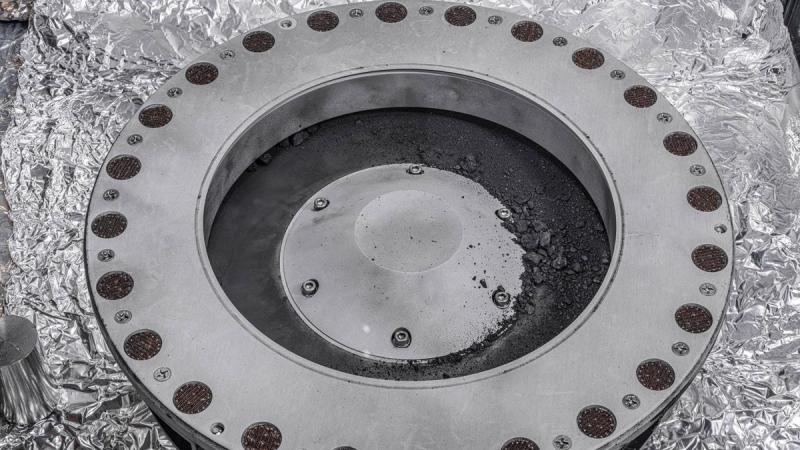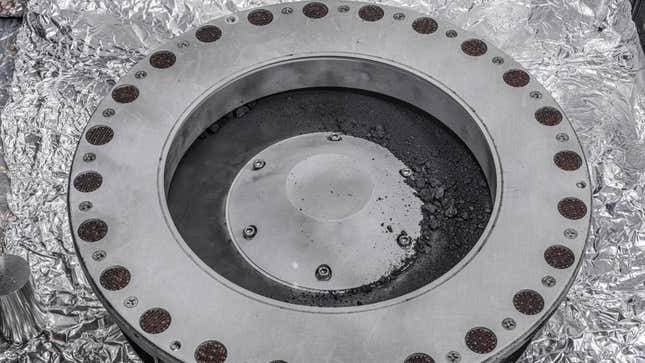NASA: Returned Asteroid Samples Are an 'Astrobiologist's Dream'



ByPassant RabiePublished2 hours agoUpdated2 hours agoComments (5)We may earn a commission from links on this page.
The OSIRIS-REx canister still contains the bulk of the asteroid sample inside, but pieces of the ancient space rock found on the outside have already shown evidence of organic matter embedded within tiny bits of debris.
On Wednesday, NASA revealed the first look at samples returned from asteroid Bennu through its OSIRIS-REx mission. Scientists performed an early analysis of the asteroid sample and found an abundance of carbon and water molecules, supporting the theory that the building blocks of life may have made their way to Earth via asteroids.
"This is the biggest carbon-rich asteroid sample returned to Earth," NASA Administrator Bill Nelson said during the event at the Johnson Space Center in Houston. "Carbon and water molecules are exactly the kinds of material that we wanted to find, crucial elements in the formation of our own planet and they're going to help us determine the origin of elements that could have led to life."
The samples were dropped off to Earth in late September, with the OSIRIS-REx return capsule performing a parachute-assisted landing in the Utah desert after traveling through space for nearly three years. A curation team has been carefully disassembling the TAGSAM (Touch-and-Go Sample Acquisition Mechanism) head to get to the bulk of the sample.
Although they haven't even opened the sample canister yet, extra bits of the asteroid were found outside TAGSAM—an articulated arm on the spacecraft with a round sampler head at the end used to grab the sample. The entire sample far exceeded NASA's goal of collecting 60 grams from the surface of Bennu. What's been revealed so far from the bonus sample is "a combination of fine dust, as well as some of what we call intermediate sized particles," Nicole Lunning, OSIRIS-REx Lead Curator, said on Wednesday.
In order to fully preserve the asteroid debris on the outside, it's taking the team more time to open the canister. "The only problem is a great problem and that's we've found a lot more sample than we're anticipating before even getting into the TAGSAM," Francis McCubbin, curator at NASA's JSC, said at the event. "Because we need to very meticulously and carefully collect every grain, it's taking us a little longer to get inside, but the view so far is amazing."
Over the past two weeks, the team has been analyzing some of the bonus sample using an electron microscope, infrared measurements, X-ray diffraction, and chemical element analysis. The collected sample so far is 4.7% carbon by weight, making it the highest abundance of carbon ever measured in an extraterrestrial sample, according to Daniel Glavin, OSIRIS-REx sample analyst. It also contains abundant water in the form of hydrated clay minerals.
"We picked the right asteroid," Glavin said. "And not only that, we also picked the right sample—this is an astrobiologist's dream."
Bennu is a small, near-Earth asteroid that makes a close pass to Earth every six years or so. Scientists believe Bennu might have broken off from a much larger carbon-rich asteroid about 700 million to 2 billion years ago and drifted much closer to Earth since then. Analyzing bits of the asteroid in a lab will help scientists piece together clues on the origins of the solar system. Bennu is also a near-Earth potentially hazardous asteroid, therefore studying it closely can help us learn more about its potential threats to our planet.
The OSIRIS-REx mission launched in September 2016 and reached asteroid Bennu in December 2018. After nearly two years of observations, the spacecraft landed on Bennu and snagged a sample from its surface in October 2020. On May 10, 2021, OSIRIS-REx said goodbye to Bennu and began its journey back home to drop off its precious cargo.
Once the samples touched down on Earth, the work on the ground was only just beginning. The returned asteroid pieces will be divided among a sample analysis team of 230 global scientists for a deep dive into Bennu's composition. NASA will keep at least 70% of the sample at Johnson Space Center for future research to take place decades from now, hoping to take advantage of advanced technology in the coming years.
Some of the asteroid bits will also be made available for public display at the Smithsonian Institution, Space Center Houston, and the University of Arizona.





This is an significant discovery. Can't wait to hear what it may be.
I liked the nostalgic sci-fi flashbacks I got after reading that. this story has springboard potential for amping up the conspiracy nuts.
I suppose we could start a new rumor when the next big virus pandemic hits. Haha! It was only last week I watched the Big Bang Theory episode where Leonard dreams he turns into a zombie after cutting into a meteorite.
Uh...the Andromeda Strain, anyone?
... space covid was the first thought that came to me.
there's quite a few movies with a similar type of doomsday virus/zombie apocalypse premise.
I of course, first thought of the Andromeda Strain, but sure space covid sounds like something. We could say it was released by aliens. Not these guys, but they look fun.
If the building blocks of life are as predominate as this would seem to imply, it can answer a LOT of questions about the origins of life. It can also imply just how populated the galaxy could be.
If it's more complex than a bacteria I would agree. It does refute 'life' starting in some secret garden on Earth 2000 years ago though.
a secret garden that an asteroid landed in...
They are actually talking about molecules that could suggest life.
Less complex. Amino acids are what we are looking for, bacteria are "life", not the building blocks.
Abiogenesis vs Panspermia. Either life can spontaneously evolve given the right ingredients in the right conditions OR life is transported from planet to planet via meteorites, comets or asteroids. We'll need a lot more exploration before that question is answered.
Not sure it's an either/or, since even if panspermia is a thing, it had to begin somewhere. That is, we're still left with the question of abiogenesis.
Stromatolites go back 3.5 billion years.
Stromatolite - Wikipedia
It was the predominate theory until abiogenesis was proven possible in a lab.
That's 6000 years ago!
I tend towards more life is transported via space debris like you said. I don't think anything can spontaneously generate life
I tend towards more life is transported via space debris
Even so that life had to spontaneously generate itself from something somewhere else.
There are self replicating proto-life molecules like RNA (and pre-RNA nucleic acid) that contribute to the theory. RNA can store and replicate genetic information like DNA, but they are fragile and less stable. The theory is that RNA and coenzymes formed under early Earth conditions to eventually evolve into protein enzymes (RNP) and eventually into DNA which is evolutionarily more stable and durable. This gets into some very heavy chemistry but there are lab experiments that give it plausibility.
I think this is a more logical theory and to steal a quote from a famous movie, "Life finds a way." It would mean life is probable on any number of Goldilocks planets.
I stand corrected. Thanks
Personally I think it is a combination of the 2. The building blocks are appearing, more and more, to be fairly common in space. However it still takes a lot for those blocks to become life itself.
It's all good. We don't have definite answers, just questions and ideas.
We don't know that yet, but I expect it to be true. If it true then both can be right in the same way. These pre-life molecules could be part of the fabric of the universe appearing everywhere. That would be a fantastic discovery!
My imagination just exploded
I'm always in awe of things like this. I find it humorous when certain people try to tell me atheists have no sense of wonder.
The world of science has more wonders to offer, than an old book that tells you that an invisible sky fairy did everything.
There is plenty of awe, wonder and beauty in the world for everyone. I know I'm the one that brought it up, but let's not get off topic on a science vs religion tangent.
True.
No matter what hypothesis one offers, there is always a question of origin.
Natural hypotheses all have abiogenesis as the starting point for life (as we know it).
Theistic hypotheses all have a deity (or deities) as the agent for the starting point of life but then that just kicks the can down the road on the immediate and even more profound question of the origin of such complex, powerful entities.
Seems to me, it is more likely inorganic matter formed into the most primitive life forms than it is for something as complex and powerful as a creator deity to form or to just eternally 'be'.
Here's the detailed plan to studying these samples. Courtesy of DrBecky's website
What's next for OSIRIS-REx? | What tests will NASA do on the asteroid sample? - YouTube
arxiv.org/ftp/arxiv/papers/2308/2308.11794.pdf
More from NASA...
I’m fond of a secret garden:
She'll lead you down the path
There'll be tenderness in the air
She'll let you come just far enough
So you know she's really there
And she'll look at you and smile
And her eyes will say
She's got a secret garden
Of course. After all, aren't they pieces of the late planet Krypton?
I'm really unhappy about bringing pieces of matter from outer space to Earth. Hasn't anyone watched the movie The Andromeda Strain?
Here's a theory for you. A trillion years ago Earth was entirely devoid of life, and it was spores of living matter on an asteroid that struck the Earth that over the millennia evolved.
The P anspermia theory.
That really doesn't need to be a way for life to start, you just need the building blocks of an acid which in the crystalline form is Ribonucleic Acid and the crystalline form keep copying itself until all building blocks are used up and the only other source is other strands of RNA and the competition begins the eat or be eaten which starts the evolution of life to become on top of which ever side is chosen.
To me life is the natural state in the universe, it just depends on how far it gets before the circle gets broken.
Earth is only about 4.58 billion years old.
That level of science is beyond me.
I stand corrected - it was a wild guess.
It also contains abundant water in the form of hydrated clay minerals.
That would explain why the heat from the sun didn't drive off the water, the water is molecularly locked in the clay, but now the question, where did the clay come from in space? I would tend to believe the asteroid was just collecting material that was ejected from Mars just as earth has been collecting material from a Martian asteroid impact, we already know the building blocks of life exist and existed on Mars. What they collected may not be as old as they think it is.
How & where do these particulates form are questions they are hoping to get some answers from with the samples. They will also try to date the samples.